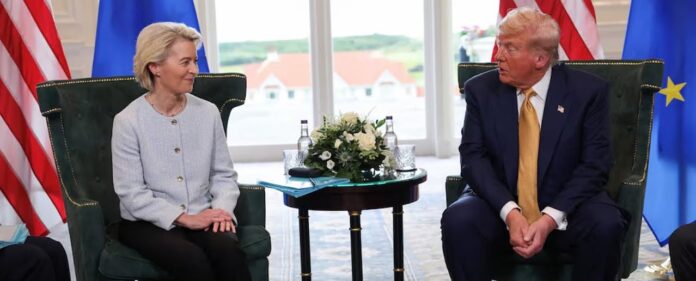Europe averts 30% tariffs as Trump strikes 15% deal with billions in EU investment and energy pledges
At Donald Trump’s luxury golf resort in Scotland, a landmark trade agreement between the United States and European Union was struck, ushering in a new, if uneasy, era of transatlantic cooperation.
The deal, unveiled on Sunday following high-stakes negotiations between President Trump and European Commission President Ursula von der Leyen, will impose a 15% blanket tariff on all EU exports to the US starting Friday. In return, the EU has pledged to make hundreds of billions of dollars’ worth of investment in the American economy, including substantial energy purchases.
Trump, characteristically grandiose, declared it the “biggest deal ever made” during a press conference at his Turnberry resort. “This is the kind of leadership America deserves,” he said, flanked by von der Leyen. The Commission President called the agreement a “huge deal,” noting it would bring predictability and stability to a previously volatile relationship.
This sweeping tariff structure replaces Trump’s earlier threat to impose 30% duties on EU goods, a move that many feared would escalate into a damaging trade war. Von der Leyen emphasised that the deal is meant to “rebalance” trade between the two sides, hinting at EU willingness to address the longstanding US trade deficit.
European leaders offered cautious support. German Chancellor Friedrich Merz described the agreement as preserving Europe’s “fundamental interests,” while Italian Prime Minister Giorgia Meloni said the deal appeared positive, though she reserved full judgement pending further detail. Irish Prime Minister Micheál Martin praised the agreement for protecting Irish jobs, noting the country’s heavy reliance on the US export market. In 2024, Ireland exported £60.4 billion worth of goods to America.
But the reaction wasn’t universally optimistic. Critics across Europe pointed to the 15% tariff as a steep price for stability, warning it could drive up consumer prices and hurt smaller exporters. Still, the general tone across EU capitals was one of relief—especially given Trump’s fiery rhetoric earlier this year.
In April, Trump lambasted the EU’s trade practices, accusing Brussels of “ripping off” the US. His administration has long harboured grievances about America’s $235.9 billion goods deficit with the bloc. Trump has argued that this imbalance represents lost American wealth, though economists argue the issue is far more nuanced.
He has also bristled at European regulatory barriers that make it harder for US firms to sell goods—particularly in agriculture and automotive industries. By securing massive investment pledges and lowering the tariff threat from 30% to 15%, Trump is positioning the deal as a vindication of his hardline tactics.
Von der Leyen, however, offered a different spin. She spoke of sustainability and long-term cooperation. “We want a more sustainable, balanced partnership,” she said, carefully avoiding any celebratory tone that might inflame EU sceptics back home.
While the deal undoubtedly reshapes transatlantic trade, much remains unclear. Specifics about sectoral carve-outs, regulatory alignment, and enforcement mechanisms were not publicly released. Analysts expect details to emerge in the coming days as both sides prepare for legislative hurdles and market reaction.
The US President’s next stop is a scheduled meeting with UK Prime Minister Keir Starmer, where similar trade topics are expected to dominate. For now, Trump basks in what he views as a victory, casting himself once again as the master negotiator on the world stage.
